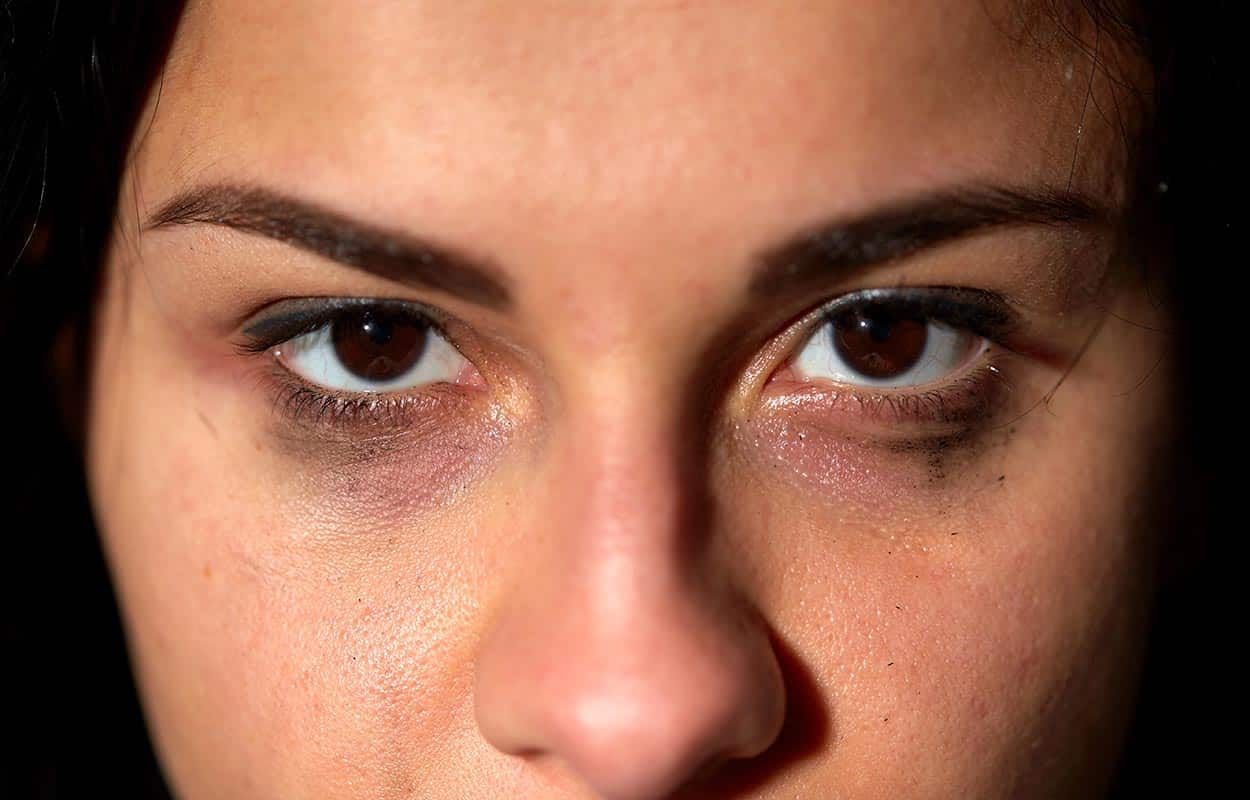What Does It Mean If Someone Has “Meth Eyes”?
Medically Reviewed By:
Written By:
Updated On: June 9, 2025
Last Medical Review On: June 9, 2025

Table of Contents
Key Points
- Meth eyes may indicate methamphetamine abuse and can look like dilated pupils, bloodshot eyes, and rapid blinking.
- Meth users may feel the physical effects of meth eyes, including blurred vision, blind spots, and even visual hallucinations.
- The use of methamphetamines leads to an increased risk of experiencing eye disorders such as glaucoma, corneal ulcers, and retinal tears, for instance.
- Meth use poses serious health risks, including cardiovascular complications, stroke, and seizures, all of which can be life-threatening.
- Signs of meth addiction include cravings, unsuccessful attempts to quit, or using meth despite it causing significant problems in life.
- If you or a loved one shows signs of meth addiction, it’s important to seek treatment as soon as possible.
What Are Meth Eyes Exactly?
“Meth eyes” is an informal term that refers to methamphetamine’s physical effects on a person’s eyes. Typically, the presence of meth eyes results in noticeable physical effects like dilated pupils, eye redness, and rapid blinking. Meth eyes can also refer to less noticeable effects, such as blurry vision, blind spots, and other forms of visual impairment.
Some say the eyes are the window to the soul. They can also reveal a dangerous drug addiction, in some cases. The presence of meth eyes can be an indication of meth abuse or addiction. Meth eyes can also be a sign of harmful effects on a person’s eyes and vision. There are other serious effects of methamphetamine use to consider, including the risk of addiction and physical dependence.
Methamphetamine use disorder is a serious medical condition that should be addressed promptly with evidence-based treatment. The longer a person abuses meth, the more difficult it might be to stop. Methamphetamines also harm the brain and the body, leading to worsening health conditions over time.
What Do Meth Eyes Look and Feel Like?
A person’s eyes may look and function differently after taking methamphetamines. This effect is colloquially referred to as “meth eyes”. Typically, loved ones are interested in the signs of meth eyes as a possible indicator of methamphetamine use. Meth use can also have serious effects on a person’s overall health and well-being, including addiction and dependence.
Visible Signs Of Meth Eyes
There are some visible signs of meth eyes in someone who has recently taken methamphetamines or who chronically abuses methamphetamines, including: [1]
- Dilated pupils
- Rapid eye movements and rapid blinking
- Bloodshot eyes
Keep in mind that these signs don’t necessarily mean a person is abusing methamphetamines, but it could be one piece of a larger puzzle.
Less Visible Signs of Meth Eyes
There are some other signs of meth eyes that only meth users may notice, such as: [2]
- Blurry vision
- Blind spots
- Visual hallucinations
If a loved one complains about these symptoms, and there are other signs of methamphetamine use, it could be a cause for concern.
Effects of Meth on Eye Health
The noticeable effects of meth use represent just one side of the coin. On the other side, methamphetamines can cause serious damage to the eyes, resulting in vision loss as well as symptoms and conditions like: [3]
- Vision impairment
- Cortical blindness
- Scotoma
- Retinal vascular occlusive disease
- Glaucoma
- Nystagmus
- Torn retina
- Reduced blood flow to the eyes
- Retinopathy
- Corneal ulcers
Some meth-related eye conditions, such as retinopathy or early glaucoma, may not cause symptoms initially. It’s important to get regular vision screenings for early detection of any existing eye problems. This could be especially true for meth users.
What Is Meth?
The use of methamphetamines, or meth, causes meth eyes. Crystal meth, also referred to as ‘ice’ or ‘Tina,’ is a street form of methamphetamine, a potent synthetic stimulant. Meth is one of the most frequently abused drugs in the United States. The U.S. Drug Enforcement Administration (DEA) has classified meth as a Schedule II controlled substance. [4 ]
The prescription form of methamphetamine, sold as Desoxyn, is FDA-approved for the treatment of ADHD and exogenous obesity, but its use is rare due to its high abuse potential. This medical use is carefully monitored by a healthcare professional who is aware of the risks of meth abuse and addiction.
Meth is only available by a non-refillable prescription from a licensed healthcare provider. [5] Any other use of this substance, including recreational use, is illegal and considered substance abuse.
What Does Meth Do?
Methamphetamine stimulates the central nervous system by increasing the release and blocking the reuptake of dopamine, norepinephrine, and serotonin in the brain. Many meth users report experiencing a temporary “high” or feeling of euphoria. Since this feeling can be both intense and fleeting, people can become addicted quickly. They may continue chasing the initial high, crashing, and then experience intense cravings, causing the cycle to begin again and again.
Dangers of Meth Use
Illicit methamphetamine is among the most harmful stimulants commonly abused in the United States, with high addiction potential and severe long-term health consequences. There are many dangers of using methamphetamines, and some of them are life-threatening.
Short-Term Side Effects of Meth Use
Some of the short-term effects of using methamphetamines include: [6]
- Pupil dilation
- High blood pressure
- High body temperature
- Increased heart rate
- Rapid breathing
Long-Term Effects of Meth Use
Many people get addicted to meth and abuse it on a long-term basis. These people face additional, long-term effects of methamphetamine use, such as: [7]
- Drastic weight loss
- Mental health effects like anxiety and confusion
- Itchy skin
- Sores on the skin from scratching
- Meth mouth
- Rotting teeth and other dental problems
Signs of Methamphetamine Abuse & Addiction
Meth eyes can be one indicator of methamphetamine abuse and methamphetamine addiction, but there are other potential signs such as: [8]
- Extreme weight loss due to a lack of appetite
- Memory problems
- Changes in facial appearance (i.e., meth mouth)
- Paranoia (A meth user may become distrustful of family members or close friends.)
- Agitation and irritability
- Psychotic episodes (i.e., hallucinations and/or delusions)
- Aggressive behavior
- Spending an excessive amount of time using meth, recovering from meth, or acquiring meth
- Change in sleeping habits
- Using meth in dangerous situations
- Needed more meth to have the same effect (i.e., building tolerance)
- Trying to quit or cut back on meth without success
- Experiencing meth cravings
- Continuing to abuse meth despite it causing problems with work, school, or relationships
- Continuing the drug abuse despite it exacerbating medical or mental health conditions
- Experiencing withdrawal symptoms when the effects of meth wear off (i.e., physical dependence)
If you or a loved one is demonstrating several of the above signs of meth addiction, with or without the presence of meth eyes, it could mean you have a problem with meth. Treatment is available, but it is crucial to act quickly. Meth addiction will only continue to get stronger if left untreated.
Helping Someone With a Meth Problem
If you think you or someone you love has a substance use problem, it’s imperative to get professional help. Since methamphetamines carry a high risk of addiction, it may not be safe or effective for methamphetamine users to try to quit on their own. They may require medical detox due to the severe side effects of meth withdrawal.
Signs of Meth Withdrawal
Some withdrawal symptoms, such as anxiety or insomnia, may resemble the comedown effects of meth but are physiologically distinct. There are other symptoms of withdrawal from meth, including: [9]
- Intense cravings
- Insomnia
- Low energy
- Depression
- Increase in appetite
- Paranoid thoughts
- Difficulty concentrating
Signs of withdrawal from methamphetamines may indicate addiction or physical dependence. If you notice these signs in yourself or a loved one, you may want to begin exploring your treatment options.
Help Is Available for Meth Addiction
Continued methamphetamine use is a sign of a treatable substance use disorder, not a reflection of moral character. It means that there may be a medical condition (i.e., addiction) that needs to be treated. Just like many other medical conditions, you won’t get better unless you seek assistance from a qualified professional. There continues to be a stigma regarding addiction in the United States. Don’t let this stop you from asking for help. Everyone deserves quality care for substance use disorders.
Frequently Asked Questions About Meth Eyes
What drug causes pinpoint pupils?
Methamphetamines typically cause the eyes to dilate or get bigger. Some drugs have the opposite effect, causing pupils to get very small. This is often referred to as pinpoint pupils. Substances that may cause pinpoint pupils include opioids such as fentanyl, oxycodone, and codeine.
Can you identify meth use from meth eyes?
While eye-related symptoms may suggest methamphetamine use, they are nonspecific and can be caused by other substances or medical conditions. Other medical conditions and environmental factors can cause symptoms that resemble meth eyes.
What does methamphetamine use do to your vision?
Using methamphetamines for any period can have negative effects on eye health. Not only can it cause various eye disorders, but it can also lead to vision impairment or even permanent vision loss.
There is a Better Way to Live. It's Time to Get the Help You Deserve.
Take the first step in getting your life back. Speak with our admissions team today.Sources
[1] [2] [3] How meth affects your vision. Meth Eyes: Understanding the Ocular Effects of Methamphetamine. (n.d.). https://www.allaboutvision.com/conditions/related/affects-of-meth-on-eyes/
[4] Drug scheduling. DEA. (n.d.-a). https://www.dea.gov/drug-information/drug-scheduling
[5] U.S. Department of Health and Human Services. (2025b, January 30). Methamphetamine. National Institutes of Health. https://nida.nih.gov/research-topics/methamphetamine#what-is-methamphetamine
[6] [7] U.S. Department of Health and Human Services. (2025d, April 23). Mind matters: The body’s response to methamphetamine. National Institutes of Health. https://nida.nih.gov/research-topics/parents-educators/mind-matter-series/methamphetamine
[8] [9] GoodRx. (n.d.-c). Meth addiction: Common signs that someone is using meth. GoodRx. https://www.goodrx.com/conditions/stimulant-use-disorder/meth-addiction-symptoms



